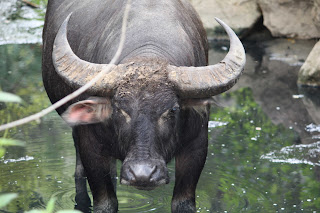Once the galley was loaded, we headed first to Loh Buaya which is still inside the Komodo National Park area on Rinca Island, but is not as commercialized as Komodo Island. It is located inside a deep protected harbor and we anchored right off the ranger station. We had to buy a 3-day pass, so we waited until 7AM the next day to go ashore. They hit us with all sorts of fees including the park fees, anchoring, bringing our camera and our tour guide. I started to feel like I was being fleeced until I calculated that all the fees added up to about $28 US. We were told that most of the wildlife including the dragons are more active in the morning and we were not disappointed. We were assigned an English-speaking guide and we proceeded to go on about a 4 hour hike.
We saw many of the big dragons and much of the food that they eat roaming free. The dragons’ food include the Timor deer, the main prey of the Komodo dragon, water buffalo, wild boar, and long-tailed macaques. The water buffalo were lying in the streams keeping cool and were unafraid of us. We learned that Rinca Island has many more dragons than Komodo Island.
The Komodo dragon (Varanus Komodoensis) is a giant lizard that is only encountered at Komodo National Park. The species is the last of its kind and it will be of no surprise that because of this they are protected by law. The Komodo Dragon - or ora as the locals call them - can grow up to 3 to 4 meters in length. Its ancestors roamed the earth up to about half a million years ago. Although these lizards are considered to be harmless, it is advisable to keep them at a distance. Our guide carried a forked stick to fend off a charging dragon, but we were not threatened by the dragons.
More of a threat to us were the villagers trying to sell us carved wooden dragons, pearls and tee shirts. We ended up buying some of all three during our two weeks roaming the park islands. We also had an encounter with a coast guard official on Rinca who insisted that we needed to officially check in with him for another $10 worth of forms, paper and stamps.
Next we moved over to the main anchorage of Loh Liang on Komodo Island and did a similar (but shorter) tour of that island. On this island we saw many more of the Timor deer and they also seemed to be unafraid of man. From the rangers here, we learned where the public moorings are located. Using the moorings made our anchorages more secure since most are quite deep and with the reversing tide/currents, we are always worried about dragging. The winds have been light, but with a 80 foot deep anchorage, I would put out about 320 feet of chain which makes quite a big swinging radius!
We stayed next at pink beach and enjoyed fine pink sand and clear water for snorkeling.
Next we went to what we thought would be a peaceful spot on the west side of Rinca, but the roll was really bad from swell. The next day we dropped to the very south of Rinca and found a mooring behind Nusa Kode that was delightful. We saw wild dragons, deer, boars and eagles right from the boat and no rangers or villagers were there. It was so nice and peaceful here that we decided to spend three nights in this area.
We did see a couple of live-aboard dive boats and Emily and I did a SCUBA dive one afternoon with them. It cost me one pack of cigarettes to get our two air bottles refilled. This is where cruising on your own boat is really nice. These dive boats have to cram in 6 dives per day and then they leave at 5AM to the next spot. We can linger where we like and leave when nothing holds our interest.
Next we crossed over to the very south of Komodo where we hoped to see large manta rays again. Because we did not know exactly where they were and it was rolly there, we quickly moved around a protected point and found a quiet mooring for the night.
We stopped one night on Padar Island and found a delightful white sand beach and fair coral. We took the machete ashore and had a couple of drinking coconuts while Emily built elaborate sand mazes for the hermit crabs.
We have shared most of the anchorages with Indonesian fishing boats and have bought lobster and fish from them and even given drinking water when asked. They typically come in about 4PM and leave at about 6AM for more fishing. They rarely come by our boat, but always wave excitedly when we shout hallo.
We tried to visit Sebayur Island, but by the time we arrived, the wind had shifted and the anchorage looked rough and undesirable. The captain immediately headed west and we found a better mooring on the south side of Lawadarat that had good snorkeling and another nice beach. That mooring was a little rolly at night, so after a morning snorkel, we moved ½ mile south and grabbed another mooring. The next morning we were joined by another dive boat so Emily and I did a nice dive with them. Saw a turtle, 9 scorpion fish and plenty of life while the captain of the dive boat circled above us in my dingy.
As our time in Indonesia is limited and the rain storms are becoming more numerous (but quick), we decided to re-provision once more in Labuan Bajo and start heading further west towards Bali.
Tom




























No comments:
Post a Comment